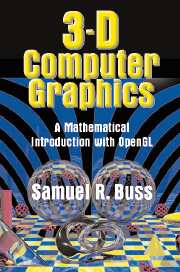Book contents
- Frontmatter
- Contents
- Preface
- I Introduction
- II Transformations and Viewing
- III Lighting, Illumination, and Shading
- IV Averaging and Interpolation
- V Texture Mapping
- VI Color
- VII Bézier Curves
- VIII B-Splines
- IX Ray Tracing
- X Intersection Testing
- XI Radiosity
- XII Animation and Kinematics
- A Mathematics Background
- B RayTrace Software Package
- Bibliography
- Index
- Plate section
I - Introduction
Published online by Cambridge University Press: 05 June 2012
- Frontmatter
- Contents
- Preface
- I Introduction
- II Transformations and Viewing
- III Lighting, Illumination, and Shading
- IV Averaging and Interpolation
- V Texture Mapping
- VI Color
- VII Bézier Curves
- VIII B-Splines
- IX Ray Tracing
- X Intersection Testing
- XI Radiosity
- XII Animation and Kinematics
- A Mathematics Background
- B RayTrace Software Package
- Bibliography
- Index
- Plate section
Summary
This chapter discusses some of the basic concepts behind computer graphics with particular emphasis on how to get started with simple drawing in OpenGL. A major portion of the chapter explains the simplest methods of drawing in OpenGL and various rendering modes. If this is your first encounter with OpenGL, it is highly suggested that you look at the included sample code and experiment with some of the OpenGL commands while reading this chapter.
The first topic considered is the different models for graphics displays. Of particular importance for the topics covered later in the book is the idea that an arbitrary three-dimensional geometrical shape can be approximated by a set of polygons – more specifically as a set of triangles. Second, we discuss some of the basic methods for programming in OpenGL to display simple two- and three-dimensional models made from points, lines, triangles, and other polygons. We also describe how to set colors and polygonal orientations, how to enable hidden surface removal, and how to make animation work with double buffering. The included sample OpenGL code illustrates all these capabilities. Later chapters will discuss how to use transformations, how to set the viewpoint, how to add lighting and shading, how to add textures, and other topics.
Display Models
We start by describing three models for graphics display modes: (1) drawing points, (2) drawing lines, and (3) drawing triangles and other polygonal patches. These three modes correspond to different hardware architectures for graphics display.
- Type
- Chapter
- Information
- 3D Computer GraphicsA Mathematical Introduction with OpenGL, pp. 1 - 16Publisher: Cambridge University PressPrint publication year: 2003



